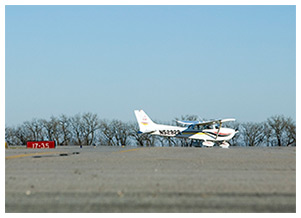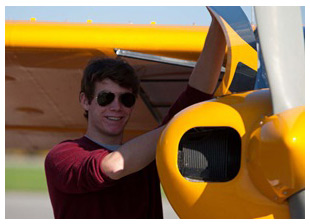Training Tips
|

A pilot lands a Cessna 172 and discovers that under a notice to airmen (notam) in effect, the airport is closed. At another field, a departing pilot fails to comply with a temporary flight restriction's (TFR) requirement to obtain a transponder code before takeoff. A pilot blunders into airspace being used by aircraft practicing for an upcoming airshow, creating a collision hazard.
What lapse did these pilots have in common? In each case, the pilot started the process of obtaining a preflight briefing, but failed to complete the task. Each pilot got sloppy.
A student pilot learns early in training that the first step in preparing for a flight scheduled several hours or more in the future is to request an outlook briefing from flight service. But don't stop there.
"An outlook briefing should be requested when a planned departure is six hours or more away. It provides initial forecast information that is limited in scope due to the timeframe of the planned flight. This type of briefing is a good source of flight planning information that can influence decisions regarding route of flight, altitude, and ultimately the go/no-go decision," explains the Pilot's Handbook of Aeronautical Knowledge.
The discussion goes on to emphasize what to do next: "A prudent pilot requests a follow-up briefing prior to departure since an outlook briefing generally only contains information based on weather trends and existing weather in geographical areas at or near the departure airport. A standard briefing near the time of departure ensures that the pilot has the latest information available prior to their flight."
As the incidents (each reported to the Aviation Safety Reporting System by the pilot involved) demonstrate, weather isn't the only critical information to update before flying. Notams, especially TFRs, can change with little notice. To depend on an outlook briefing for information about TFR procedures or scheduling is a potentially serious error.
Never leave assumptions unverified: It had not occurred to the pilot who tangled with the airshow aircraft that they would be up working on their routines so soon. Having received an outlook briefing the previous day, the pilot admitted passing up several opportunities to receive updates before flying, and compromised safety.
"On this flight I got sloppy and it bit me," the pilot reported. "I guarantee it will never happen again."
|
|
Flight Training News
|
|
Rotorcraft Rookie
If you are going to learn to fly a helicopter you first have to learn how to control it.
Read more...
Share:
 
Waco, Texas-based FreeFlight Systems is now offering ADS-B University, an online series of seven video briefings. The videos give pilots, aircraft owners, fleet operators, aviation professionals, and others a practical understanding of how Automatic Dependent Surveillance-Broadcast (ADS-B) works and the equipment needed to operate in the NextGen airspace system. The short videos discuss ADS-B technologies, requirements, applications, and benefits in 5 minutes or less. The entire series can be viewed in less than 30 minutes.

AOPA Foundation focus
Thanks to a grant from the AOPA Foundation, the Girls Inc. chapter in Oak Ridge, Tenn., is offering its members training in science, technology, engineering, and mathematics via the SkyGirls program.
Read more...
Share:
 
Liberty University's School of Aeronautics has added a new Piper Arrow training aircraft to its fleet. The Piper Arrow is the preferred aircraft for the university's Air Race Classic team, the "Liberty Belles," which competed in the annual cross-country race in 2013. Liberty plans to replace and expand its fleet of Piper Arrows and twin-engine Piper Seminoles. Liberty's fleet also includes Cessna aircraft.
Video
On Dec. 6, 1999, UA 1448 made one wrong turn while taxiing in severely reduced visibility. It became the first link in a chain of mistaken assumptions by its crew and the tower controller. View this animation of the eerie events that took place that dark, foggy night at Rhode Island's Theodore Francis Green State Airport, to learn how runway incursions happen in just seconds, whether a single miscalculation or a host of slipups converging at the wrong time.
Watch the video...
Share:
 
Login required
While pilots strive for excellence in their flying abilities, their skills in radio communications can often be limited. Yet, your verbal presence on the radio can tell a lot of people—ATC, ground personnel, and even other pilots—about you. Learn tips for how to give the best impression possible by taking the Air Safety Institute's Say It Right: Mastering Radio Communication online course.
Take the course...
|
Training Resources
|
|
Login required
Created by pilots, for pilots, pilot reports (pireps) are great sources of real-time, in-flight weather conditions—offering a "sneak peek" of what you'll encounter in flight. This course covers how to get, use, and give pireps to help you become a better SkySpotter.
Take the course...
|
|
Did you know that student pilots who join AOPA are three times more likely to complete their flight training? Membership includes unlimited access to aviation information by phone (800/USA-AOPA, weekdays from 8:30 a.m. to 8 p.m. Eastern time) or from Flight Training Online or AOPA Online. If you're not already a member, join today and get the pilot's edge.
|
Scholarships
|

Article
Youths ages 13 through 18 who are members of the AOPA AV8RS program can now apply for scholarships to help them achieve their aviation dreams.
Read more...
Share:
 
Article
New aviation scholarship applications are open, and some entry deadlines are quickly approaching. Plus find out who has recently awarded scholarships.
Read more...
Share:
 
|
AOPA Live
|
|
AOPA Live This Week
Shell Aviation has developed a lead-free aviation fuel that is intended to be used across the general aviation fleet. When might it arrive? Also, hawks can teach us a thing or two about slow flight, and Dr. Jonathan Sackier covers the flu—and how to avoid it—in this week's "Fly Well" segment. As of publication deadline, AOPA Live This Week® producers were still finalizing the show, which will be available Dec. 6.
AOPA Live This Week...
Share:
 
|
|
Career Pilot
|
|
Boeing and Korean Air have begun construction of Korea's largest new aviation training facility at Incheon's Free Economic Zone (IFEZ). The new campus, slated to open in 2015, will house 12 full-flight simulators for pilot training programs.
The International Air Transport Association (IATA) and Stanford University have signed an agreement to expand the Stanford–IATA Aviation Strategy Program. The program, designed for mid- to senior-level managers in aviation and related industries, is a specialized 10-day program taught by IATA instructors, Stanford faculty, and industry experts.
|
|
For more aviation career news, see the Flight Training website.
|
Plane Spotter
|

You've come pretty far in a short time in the plane spotting game. You can parse Pipers and separate Skyhawks from Skylanes in no time flat. But now there's a new level of detail to master. The flight school's Cessna 172M is a 150-horsepower airplane, but the Cessna 172N (1977-1980) tied down alongside is a 160-hp aircraft. On the fixed-base operator's ramp they appear about the same, so here's how a plane spotter pegs the N-model: It's the one with its oil-dipstick door uniquely located on top of the engine cowling.
|
Training Products
|
|
PilotWorkshops.com is now offering IFR Mastery, a continuing series of monthly online, scenario-based workshops. Each month, users are provided with a challenging, real-world IFR scenario that tests knowledge and hones decision-making skills.
Author and pilot Brent Owens has just release the new e-book The Pilot's Guide to Flying on a Budget. The book is designed to tackle the high cost of flying head-on and it's agnostic to the type of general aviation flying being done. The goal is to share best practices to make GA as inexpensive as possible without sacrificing safety or regulatory compliance. The cost is $21.25.
|
|
Note: Products listed have not been evaluated by ePilot editors unless otherwise noted. AOPA assumes no responsibility for products or services listed or for claims or actions by manufacturers or vendors.
|
Member Benefits
|
|
Members only
The difference between a private pilot flight operation and a commercial pilot flight operation depends on whether there has been any compensation exchanged for the flight. If money passes from the passengers or the person responsible for the cargo on board, that would be considered compensation. But, could compensation mean more than money? You bet.
Read more...
Share:
 
Member benefits
From growing up without any particular interest in aviation to being hooked on flying, Nina Ortega says she couldn't have done it without her flight instructor or AOPA.
Read more...
Share:
 
|
Blogs
|
|
A Boston-based firm has grown up surrounded by educational institutions that have had a fair amount of success producing thought leaders and disruptive innovators.
Read more...
Share:
 
What's on your aviation bucket list? Even an airline pilot who flies all the time has things he wants to check off.
Read more...
Share:
 
|
Instrument Tip
|
|
IFR Fix
The slower-than-expected movement of the weather system was a good break today, but what does it mean for tomorrow's return trip toward the weather?
Read more...
Share:
 
|
Final Exam
|
Question
In an effort to increase an engine's horsepower, manufacturers have developed forced induction systems called superchargers and turbochargers. What is the key difference between them?
Answer
The key difference is what powers the device. A supercharger is powered by an engine-driven air pump or compressor while a turbocharger gets it power from the exhaust stream that runs through a turbine, which in turn spins the compressor. (Source: FAA Pilot's Handbook of Aeronautical Knowledge, page 6-11.)
|
|
Got a question for our technical services staff? Contact AOPA.
|
Career Opportunities
|
|
Aviation job board
Cirrus Aircraft is seeking experimental technicians to support the Cirrus Vision SF50 Jet program. The successful candidate will fabricate, install, modify, and repair experimental aircraft components and test equipment in accordance with maintenance manuals, component installation manuals, engineering drawings and procedures, and standard practices. This position also will develop, fabricate, and maintain molds, tools, and other equipment necessary to complete related tasks and train and assist others during early production of new products. This job of the week listing is brought to you by the AOPA Aviation Job Board.
Learn more about this and other exciting employment opportunities...
|
 |
Education and Seminars
|
Flight Instructor Refresher Courses
Dec 7-8 - Denver, Colo.; Orlando, Fla.; and Northbrook, Ill.
Jan 4-5 - Ypsilanti, Mich.; Portland, Ore.; San Jose, Calif.; and San Antonio, Texas
Jan 11-12 - Knoxville, Tenn.; Jackson, Miss.; Seattle, Wash.; and Charlotte, N.C.
Jan 24-25 - Baltimore, Md., and Long Beach, Calif.
For a complete schedule, see AOPA Online. Can't make it in person? Sign up for the Air Safety Institute's new Online eFIRC.
|
Air Safety Institute Safety Seminars
Jan 13 - Mesa, Ariz.; and Reno, Nev.
Jan 14 -Tucson, Ariz.; and Sacramento, Calif.
Jan 15 - Milpitas, Calif.; and El Paso, Texas
Jan 16 - Albuquerque, N.M.; and Santa Rosa, Calif.
Topics vary—for details and a complete schedule, see AOPA Online.
|
|
|
|
|
|
 |
|
|
ePilot Flight Training Editor:
Benét Wilson
Production Team
Katie Richardson
Lezlie Ramsey
Melissa Whitehouse |
Contributors:
Sarah Deener
Alyssa Miller
Jim Moore
Jill W. Tallman
Warren Morningstar
Alton K. Marsh
Dave Hirschman
Tom Horne
Ian J. Twombly
Dan Namowitz |
|
|
|
|